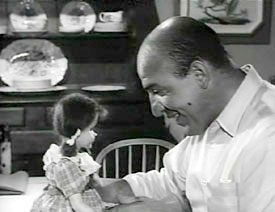 A little girl's beauteous dolly is almost as big as she is. And just as ambulatory. A little girl's beauteous dolly is almost as big as she is. And just as ambulatory.
When it goes stalking around the house at night, it's face goes all twisty-evil, & having a good long carving knife with her is de rigour. Her witchy little doll voice is pretty creepy too.
Dolly Dearest (1992), though hoping to horn in on the success of Child's Play (1988), is to large degree a remake of the classic "Talky Tina" episode called Living Doll (1963) from the fifth season of The Twilight Zone, with the subtlty of Rod Serling's era replaced with a newer slasher aesthetic.
The Twilight Zone story was accidentally credited to Charles Beaumont, but was written by Jerry Sohl. Its director Richard C. Sarafian directed such acclaimed feature films as Man in the Wilderness (1970) & Vanishing Point (1971).
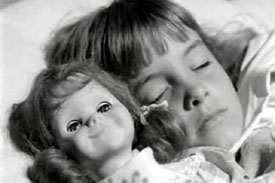 Talky Tina (voiced by June Foray) has bonded with little Christie (Tracy Stafford). The Tina doll took a dislike to Christie's stepfather (Telly Sevalis) who soon discovers the rude toy is invulnerable & trying to destroy it causes it to go from rude to vengeful. Talky Tina (voiced by June Foray) has bonded with little Christie (Tracy Stafford). The Tina doll took a dislike to Christie's stepfather (Telly Sevalis) who soon discovers the rude toy is invulnerable & trying to destroy it causes it to go from rude to vengeful.
Tina had more menace when she told mom (Mary LaRoche) sweetly, "My name's Talky Tina. And you'd better be nice to me," than when Jessica's dolly growled, "It's time to play!" -- though that's pretty cool too.
Tina was not at all animated despite that she was able to kill, & that episode was successful even so.
So too the doll of Dolly Dearest is not much of a special effect. But posing the creepy toy with a varied array of awful expressions is sufficient.
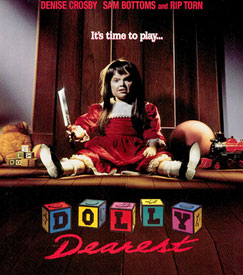 Blasted by critics when it was new, with no theatrical release at all & a failure in the VHS marketplace, it seems even bad films rarely die in the dvd era, & a forgotten film like Dolly Dearest was able to get a second wind. And turns out it's really only half as bad as critics insisted.
Blasted by critics when it was new, with no theatrical release at all & a failure in the VHS marketplace, it seems even bad films rarely die in the dvd era, & a forgotten film like Dolly Dearest was able to get a second wind. And turns out it's really only half as bad as critics insisted.
The little girl who plays Jessica (Candace Hutson) is much more adequate to her task than are the adult actors, which include the always robotic Dennis Crosby as mommy & Sam Bottoms as daddy who owns the Mexican doll factory.
The simpering way Daddy talks to his daughter makes him sound dangerously pervy, an accident of bad acting rather than intentional suspense. There's also older brother Jimmy (Chris Demetral) who provides the closest thing to comedy relief & is quite the heroic little chap.
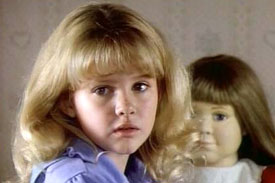 There's a scene borrowed from The Omen (1976) in which a priest blessing the family's new house causes Jessica to wig out screaming exactly like when Damian was going to be taken into a church. There's a scene borrowed from The Omen (1976) in which a priest blessing the family's new house causes Jessica to wig out screaming exactly like when Damian was going to be taken into a church.
The camera angles showing the roof of the house while Jessica goes spazzy are borrowed from The Omen's shots of church steeple, & even the score momentarily shifts to one of Damien's themes. The mastiffs in the graveyard are likewise from The Omen.
There are also elements from The Exorcist (1973) in the sets for the archeological dig from which the demon arose, & the fact that Jessica becomes possessed by the ancient evil & acts out violently speaking in an extinct language.
This manner of borrowing bits from better films may have seemed like a good idea, but copying from the most easily recognized sources might not have been the best decision.
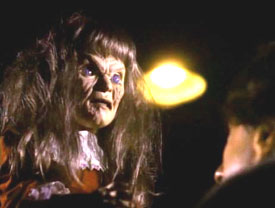 More effective is the idealistic playhouse in which Dolly & Jessica have moments of privacy. There is a real tension between the beautiful things of childhood in contrast to the terrors. More effective is the idealistic playhouse in which Dolly & Jessica have moments of privacy. There is a real tension between the beautiful things of childhood in contrast to the terrors.
There are scenes with the Mexican maid Camilla (Lupe Ontiveros) who knows "There is evil here!" Because the minority figures in such films exist primarily to be killed, Camilla all too soon discovers prayers to Jesus & Mary won't save her life.
Therefore Sister Alva (Alma Martinez), the dead maid's babe of a sister in the convent, advises Jessica's mom that the best way to fight for her daughter is with more of the useless praying thing.
Most of these complications just mark time, & many other characters come & go in the story without even the purpose of getting wacked by Dolly.
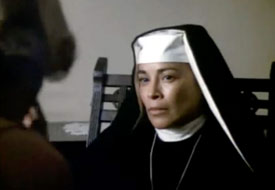 Brought to life by an ancient demonic spirit released from a 900-year-old tomb in Mexico, the "natural" form of the demon would seem to be orange streaky lights badly drawn directly onto film. Brought to life by an ancient demonic spirit released from a 900-year-old tomb in Mexico, the "natural" form of the demon would seem to be orange streaky lights badly drawn directly onto film.
The doll's background story never makes total sense. Rip Torn plays an archeologist who tries to explain it though he somehow fails to make it any clearer, though what he finds in the tomb at tale's end is cool enough.
But the fact that Jessica seems to be slowly turning into the demon dolly, & the dolly has many clones of herself over in the Mexican sweatshop of a doll factory, is sufficient creeperoonies to keep it interesting right to its happy ending, even if it doesn't really make sense if you think too much about it.
The first part of the big climax with the doll no longer hiding its evil nature, with mom & Jimmy the heroes of the piece, is perfectly satisfying.
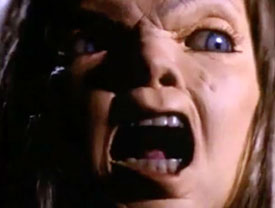 The second half of the climax, with dad in the doll factory, is intercut with a "revelation" in the ancient tribal tomb, more brutally handled because not about the child characters, & just as winning. The second half of the climax, with dad in the doll factory, is intercut with a "revelation" in the ancient tribal tomb, more brutally handled because not about the child characters, & just as winning.
So that for all Dolly Dearest reliess on plagiarisms & cliches, it's an effective cheapy.
As an aside, Dolly had a "double" played by Ed Gale, & I've a longstanding theory that no film with a dwarf in it can never be entirely without merit.
Ed can also be seen as Bob Littleton in Chopper Chicks in Zombietown
(1989); billed as "the little man" in O Brother Where Art Thou (2000), as one of Santa's elves in sundry Christmas movies, & he was Chucky's body-double in the original Child's Play. Here's a "tip of the Paglo Hat" to Ed Gale!
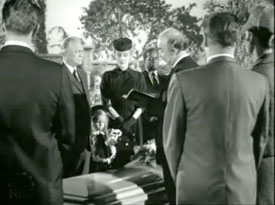 Living Doll from The Twilight Zone reminded me of another anthology series episode about a supernatural doll, Where the Woodbine Twineth (1965), an episode of The Alfred Hitchock Hour, & possessing a Bernard Hermann score that heightens without intruding upon every signal moment.
Living Doll from The Twilight Zone reminded me of another anthology series episode about a supernatural doll, Where the Woodbine Twineth (1965), an episode of The Alfred Hitchock Hour, & possessing a Bernard Hermann score that heightens without intruding upon every signal moment.
It is a faithful adaptation of a short story by the brilliant Davis Grubb, whose great horror novel The Night of the Hunter became a classic film noir, the only film directed by Charles Laughton.
Where the Woodbine Twineth runs about 45 minutes without the commercial interuptiopns, & is Southern Gothic poetry sprung to life. The teleplay was by James Bridges, who wrote & directed The Paper Chase (1973) & The China Syndrome (1979), & wrote the screenplay for the science fiction classic Colosusus: The Forbin Project (1970).
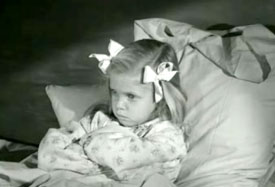 Another of Bridges' Alfred Hitchock Hour adaptations, Ray Bradbury's The Jar (1964), shares with Where the Woodbine Twineth a rural-gothic poetry of the finest sort. Another of Bridges' Alfred Hitchock Hour adaptations, Ray Bradbury's The Jar (1964), shares with Where the Woodbine Twineth a rural-gothic poetry of the finest sort.
He also wrote the teleplay for The Unlocked Window (1965) which some regard as the single most suspenseful episode of Hitchock Hour, about a serial killer of nurses, photographed by the cinematographer from Citizen Kane (1941).
Eva Snyder (Eileen Baral) is orphaned & sent to live with her only living relatives, an aged riverboat captain (Carl Benton Reid) who is gone much of the time, & his well-meaning but strict old-maid sister Nell (Margaret Leighton) who is botching her first real chance at mothering.
When Eva expresses an imaginative life with invented friends Mingo & Mr. Peppercorn, Nell is quite cruel in suppressing what she perceives as unwholesome tendencies.
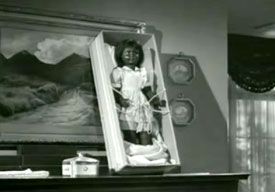 The Captain brings Eva a gift, a black doll named Numa, to whom lonesome Eva becomes strongly attached. The Captain brings Eva a gift, a black doll named Numa, to whom lonesome Eva becomes strongly attached.
When she expresses her believe that Numa comes alive from time to time, Aunt Nell becomes increasingly cruel, though not wishing to be.
One evening when Eva is supposed to be in bed, she's outside playing "where the woodbine twineth" amidst the trees. Nell sees there's a little black girl (Lila Perry) running about. Assuming the girl a trespasser & an inappropriate playmate for a white girl, she chases Numa away with a switch, warning her she had better never return.
But that's when Nell finds the white doll, which looks like Eva, who really did play the game of trading places with Numa.
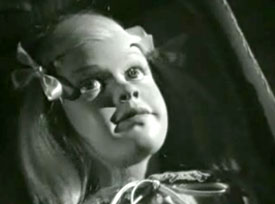 I first saw this little film when it first aired, when I was a teenager, & I was intensely moved by it, & became a lifelong fan of Davis Grubb into the bargain when I soonafter found a paperback collection of his tales including this story. I first saw this little film when it first aired, when I was a teenager, & I was intensely moved by it, & became a lifelong fan of Davis Grubb into the bargain when I soonafter found a paperback collection of his tales including this story.
I saw it again recently on "retro" television, then thinking of it today while writing, I stopped long enough to find it on the web & watched it once again.
It has aged so well, truly a beautiful little black & white film which transcends the usual level of Alfred Hitchock Hour stories, which were on average well done though rarely with this high degree of timelessness. Where the Woodbine Twineth is a highwater mark for television horror.
Not enough doll films yet? Continue to:
Pinocchio's Revenge (1996) & Evil Doll (2004)
copyright © by Paghat the Ratgirl
|
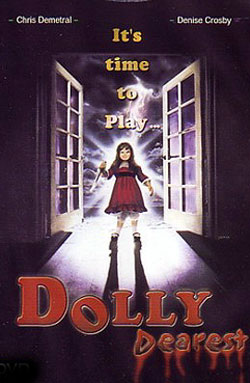

 Talky Tina (voiced by June Foray) has bonded with little Christie (Tracy Stafford). The Tina doll took a dislike to Christie's stepfather (Telly Sevalis) who soon discovers the rude toy is invulnerable & trying to destroy it causes it to go from rude to vengeful.
Talky Tina (voiced by June Foray) has bonded with little Christie (Tracy Stafford). The Tina doll took a dislike to Christie's stepfather (Telly Sevalis) who soon discovers the rude toy is invulnerable & trying to destroy it causes it to go from rude to vengeful. Blasted by critics when it was new, with no theatrical release at all & a failure in the VHS marketplace, it seems even bad films rarely die in the dvd era, & a forgotten film like Dolly Dearest was able to get a second wind. And turns out it's really only half as bad as critics insisted.
Blasted by critics when it was new, with no theatrical release at all & a failure in the VHS marketplace, it seems even bad films rarely die in the dvd era, & a forgotten film like Dolly Dearest was able to get a second wind. And turns out it's really only half as bad as critics insisted. There's a scene borrowed from The Omen (1976) in which a priest blessing the family's new house causes Jessica to wig out screaming exactly like when Damian was going to be taken into a church.
There's a scene borrowed from The Omen (1976) in which a priest blessing the family's new house causes Jessica to wig out screaming exactly like when Damian was going to be taken into a church. More effective is the idealistic playhouse in which Dolly & Jessica have moments of privacy. There is a real tension between the beautiful things of childhood in contrast to the terrors.
More effective is the idealistic playhouse in which Dolly & Jessica have moments of privacy. There is a real tension between the beautiful things of childhood in contrast to the terrors. Brought to life by an ancient demonic spirit released from a 900-year-old tomb in Mexico, the "natural" form of the demon would seem to be orange streaky lights badly drawn directly onto film.
Brought to life by an ancient demonic spirit released from a 900-year-old tomb in Mexico, the "natural" form of the demon would seem to be orange streaky lights badly drawn directly onto film. The second half of the climax, with dad in the doll factory, is intercut with a "revelation" in the ancient tribal tomb, more brutally handled because not about the child characters, & just as winning.
The second half of the climax, with dad in the doll factory, is intercut with a "revelation" in the ancient tribal tomb, more brutally handled because not about the child characters, & just as winning. Living Doll from The Twilight Zone reminded me of another anthology series episode about a supernatural doll, Where the Woodbine Twineth (1965), an episode of The Alfred Hitchock Hour, & possessing a Bernard Hermann score that heightens without intruding upon every signal moment.
Living Doll from The Twilight Zone reminded me of another anthology series episode about a supernatural doll, Where the Woodbine Twineth (1965), an episode of The Alfred Hitchock Hour, & possessing a Bernard Hermann score that heightens without intruding upon every signal moment. Another of Bridges' Alfred Hitchock Hour adaptations, Ray Bradbury's The Jar (1964), shares with Where the Woodbine Twineth a rural-gothic poetry of the finest sort.
Another of Bridges' Alfred Hitchock Hour adaptations, Ray Bradbury's The Jar (1964), shares with Where the Woodbine Twineth a rural-gothic poetry of the finest sort. The Captain brings Eva a gift, a black doll named Numa, to whom lonesome Eva becomes strongly attached.
The Captain brings Eva a gift, a black doll named Numa, to whom lonesome Eva becomes strongly attached. I first saw this little film when it first aired, when I was a teenager, & I was intensely moved by it, & became a lifelong fan of Davis Grubb into the bargain when I soonafter found a paperback collection of his tales including this story.
I first saw this little film when it first aired, when I was a teenager, & I was intensely moved by it, & became a lifelong fan of Davis Grubb into the bargain when I soonafter found a paperback collection of his tales including this story.